If you think you’ve found some white mold on wood in your home, this handy guide will give you all of the information you need to get rid of the white mold safely, and to prevent it from returning in the future.
Plus, we’ll help you identify exactly what type of white mold you’re dealing with, and outline the potential health risks and damage this type of mold can cause.
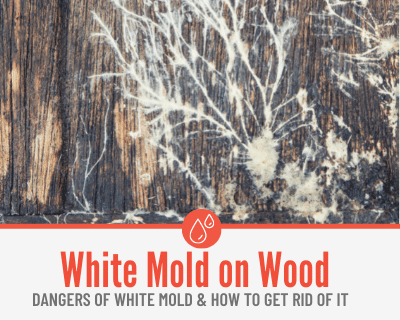
Is White Mold On Wood Dangerous?
White mold on wood can be quite dangerous – it can cause some serious health complications and even permanently damage your property if not dealt with properly.
Health Complications
White mold on wood can cause a whole range of health complications, including dizziness, eye and skin irritation, allergic reactions, and respiratory problems.
The severity of these health complications varies from person to person, with asthmatics being at the highest risk when exposed to white mold.
Damage To Your Property
White mold will ‘eat away’ at whatever material it occurs on, threatening its structural integrity.
For example, if you have white mold on the flooring in your home, you could run the risk of having those floors collapse if they become unstable enough, which is a huge health and safety risk.
Even if the white mold you find in your home is only on a small area of flooring or some furniture, it can still cause unsightly cosmetic damage and a foul smell that’s hard to get rid of.
White Mold In your Home?
Call 844-488-0570 for a Risk Free estimate from a Licensed Mold Remediation Specialist in your area.
We Can Help Remove White Mold & Prevent it from Returning
What Causes White Mold On Wood?
Just like other types of mold, the most important factors are high temperatures, high levels of moisture, and an organic, carbon-rich material to act as a ‘food source’ for the mold.
This means that places like basements are at a greater risk of white mold growth since they can often be quite damp and warm, especially during the summer months.
What Does White Mold On Wood Look Like?
White mold will appear as small white spots and patches along a surface. These white spots can either be powdery or fuzzy – read below to find out how to tell the difference.
Powdery White Mold
As the name implies, powdery white mold will look like a powdery substance that has coated your floors or furniture.
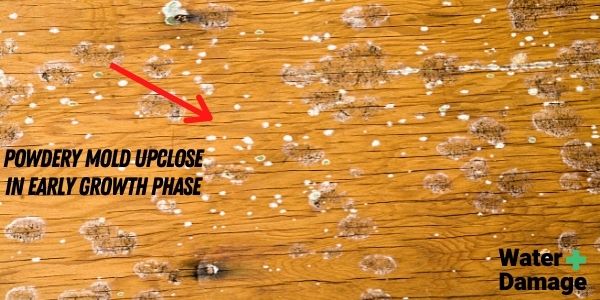
It may initially look similar to mildew or even efflorescence, which is just a harmless build-up of salt on an inorganic surface. An easy way to tell whether the powdery substance you’ve found in your home is mold is to perform a water test – mold will not dissolve when it comes in contact with water.
While there are many species of mold, the Aspergillus mold is often the culprit behind powdery-looking white mold on wood.
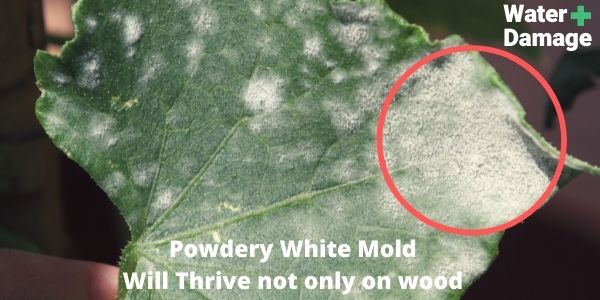
White Fuzzy Mold
White mold on wood can also appear as round, fuzzy patches all over a surface.
This type of mold looks very similar to the mold you’ll see growing on rotten food and is a bit easier to identify than powdery white mold.
The most common types of fuzzy white mold are the Penicillium mold or the Cladosporium mold.
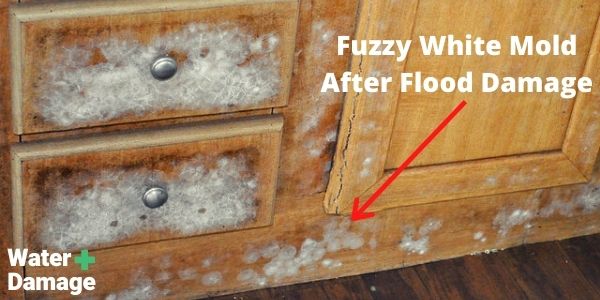
What Kills White Mold On Wood
Does Vinegar Kill White Mold On Wood?
Vinegar can be a quite good solution for white mold if used properly. Since it’s a mild acid, it can kill a large percentage of mold species – experts estimate around 82%.
Wiping surfaces down with vinegar can even prevent future mold outbreaks on wood, though other factors like humidity and temperature can largely affect that.
To kill white mold on wood with vinegar, cover the affected area with vinegar and let it sit there for about 60 minutes before trying to scrub or wipe it.
Depending on the amount of mold present and the severity of the growth, you may need to wait longer or re-apply the vinegar.
Does Bleach Kill White Mold On Wood?
While using bleach can be a great way to get rid of mold in general, it actually shouldn’t be used against white mold on wood.
This is because bleach only kills mold that’s present on non-porous surfaces like tiles or sinks and tubs – mold spreads really deep into porous materials like wood and bleach can’t seep in deep enough to get rid of it all, so the mold would eventually return to the area.
Another concern with using bleach to kill white mold is the potential health risks associated with it.
While household bleach isn’t normally toxic or corrosive, it can still cause skin irritation and even respiratory problems if used in a room without ventilation.
Does Baking Soda Kill White Mold On Wood?
Similar to vinegar, a solution of baking soda and water can be effective against white mold on wood.
Despite being quite mild, baking soda does a great job of killing mold and ensuring it doesn’t return. It even gets rid of that musty mold smell!
Simply spray the affected area with the baking soda and water solution, then scrub the area with a brush to remove the mold. Make sure to thoroughly rinse and dry the area afterward to ensure no residue is left behind.
Does Liquid Detergent Kill White Mold On Wood?
Using liquid detergent is not an effective method of getting rid of white mold on wood.
The average liquid detergent simply does not contain chemicals that are strong enough to kill mold, and will therefore not affect it.
There are some special detergents out there, designed specifically for tackling mold, but those can be quite expensive and hard to track down.
How To Get Rid Of White Mold On Wood
White mold can affect pretty much any wooden surface within your home – from furniture, to paneling, to flooring. The methods you should use to get rid of white mold largely depend on where exactly the growth is happening and how big of an area it covers.
White Mold On Wood Furniture
White mold appearing on wood furniture is an incredibly common occurrence, especially if you have furniture stored in a basement or loft.
Factors such as being near heaters or damp stone walls can all increase the risk of your furniture developing white mold.
White mold on furniture can create unsightly cosmetic damage if left untreated, such as holes and cracks in the surface. It can also cause the integrity of the furniture to decrease, even causing it to break entirely or collapse.
Removing White mold From Wooden Furniture
- Take the furniture outside if possible. The last thing you want is any loose spores coming off the furniture while you clean it, as they may latch onto a different surface and continue propagating.
- If that isn’t possible, make sure to do the next steps in a well-ventilated room, ideally even while wearing a face covering to protect yourself.
- For furniture, we recommend using a solution of baking soda and water, as you can just spray it onto the wood and start scrubbing almost immediately.
- You can use vinegar too, although this might not work for every type of furniture – remember, vinegar needs to sit on the surface for at least 60 minutes to be effective, so you may need to turn your furniture on its side to allow for this.
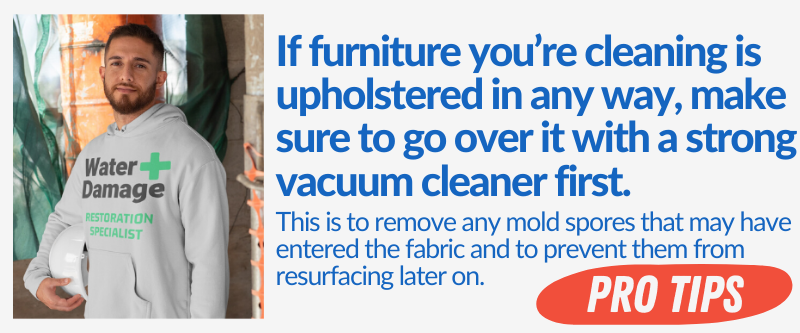
How can you prevent the White mold from returning?
- Simply using vinegar or baking soda is quite a good way to prevent the mold from returning. Both of these solutions remove the mold entirely, meaning that it shouldn’t come back any time soon.
- Moving furniture out of the basement/loft or away from heaters is another good prevention method.
White Mold On Basement Wood
White mold on basement wood is another common occurrence since basements tend to be quite damp and warm, allowing mold to thrive. The ease of tackling white mold in a basement depends on the size of the area affected and the severity of the growth.
White mold will ‘eat away’ at the wood itself, making it much weaker and more susceptible to breaking.
This may eventually lead to the wood collapsing, potentially injuring a person or damaging any items stored in the basement.
So, how should you tackle it?
- Assuming it’s a small to moderately sized infestation, you will be able to get rid of the white mold using either vinegar or baking soda and water. We would recommend using vinegar as it can soak through to the lower layers of the wood, ensuring the entire colony of mold is killed off.
- Make sure to wear some protective gloves while using vinegar, and to get as many windows open as possible to keep the basement aired out.
- You should contact a professional if the mold growth spans more than just a meter or two in your basement to ensure your safety.
How can you prevent the White mold from returning?
- As with furniture, simply using vinegar on the affected area should be a great way of preventing the white mold from returning, especially if you let it seep into the deepest parts of the wood.
- You should try your best to keep the basement well ventilated, and potentially invest in some dehumidifiers to control moisture levels.
White Mold On Wood Under The House
Tackling white mold on the wood under your house can be quite tricky, mostly because it’s a hard-to-reach area.
Just like in the basement, white mold growth under the house will usually occur due to high temperatures and high levels of humidity.
The damage caused here is possibly the most dangerous – parts of the floor collapsing, walls sinking deeper into the ground, and even potential harm to your physical health are all things that need to be considered when tackling white mold on the wood under the house.
So, how should you tackle it?
- Since it’s such a hard-to-reach area of your home, our first recommendation would be to contact a professional to help you out. You may not be able to access the area underneath your house by yourself and may need specialist equipment to clean the area affected by the mold.
- However, if you can easily reach the area, use baking soda and water to get rid of the white mold. You’ll want to get in and out of there as fast as possible, so using a solution you can scrub straight away is the best option.
- Most importantly, make sure to wear gloves, some form of face covering, and even safety goggles if you have access to them.
How can you prevent the mold from returning?
- As already mentioned, baking soda should successfully prevent the white mold from returning if used properly.
- If hiring a professional, they should also be using solutions that prevent any future mold growth in that area.
- Additionally, performing regular checks of the underneath of your house can help you catch early signs of a white mold infestation if it were to ever return, letting you tackle it before it gets unmanageable.
White Mold On Wood Paneling
If you live in a quite warm climate or have recently moved into a property that stood vacant for some time, you may encounter white mold on your wood paneling.
Previous incomplete removal of white mold may also cause some growth to re-emerge on your wood paneling.
While the mold probably won’t cause too much physical damage since it’s just paneling, it can cause unsightly cosmetic damage that would require covering or replacing.
It can also cause a very unpleasant, musty smell to permeate your whole home.
So, how should you tackle it?
- Either vinegar or baking soda should work just fine, though we would recommend baking soda over vinegar since it’s a bit milder – some wood paneling can be a bit too delicate to use strong chemicals on it.
- After spraying down and scrubbing the affected area, make sure to thoroughly dry it, as any remaining moisture may seep underneath the paneling and cause further damage or detach the paneling from the surface underneath it.
- You may want to contact a professional if the affected area is quite large, or if you’re worried about potentially damaging your wood paneling in the process of removing the white mold.
How can you prevent the white mold from returning?
- Make sure the room where the infestation happened doesn’t get too hot or humid – invest in some dehumidifiers and keep the windows open as often as possible.
- Also, as mentioned before, using baking soda properly should ensure that the white mold never resurfaces.
- If you’re able to, have a professional check whatever is underneath your wood paneling to make sure there aren’t any mold spores that may cause future growth.
White Mold On Wood Flooring
If the wood flooring is located in places like the living room or bedroom, you probably won’t have to deal with white mold unless you live in a warm climate. Previous improper cleaning of white mold may also result in it returning, just like with wood paneling.

So, how should you tackle it?
- Both vinegar and baking soda should work equally as well as each other on wood flooring, as long as you make sure to remove any remaining moisture once you’re finished.
- As usual, make sure to keep the room you’re working in well ventilated – a combination of loose spores and difficult smells from both the mold and vinegar you’ll be using can prove quite dangerous!
How can you prevent the white mold from returning?
- Dehumidifiers will help you control moisture levels in the affected room, removing one of the factors needed for mold to grow.
- Also, ensuring the area was soaked quite well with the vinegar or baking soda solution, and wiped down thoroughly afterward should stop the white mold from returning.
White Mold On Wood Cabinets
All of the cooking that happens in a kitchen can create a quite warm and humid environment – the perfect breeding ground for mold!
White mold appearing on wood cabinets is incredibly dangerous – if those cabinets contain any sort of food, it could become contaminated, and cause severe health complications.
Avoid consuming anything that was stored in a cabinet with white mold on it.
So, how should you tackle it?
- If the mold is located on the cabinet door, consider removing the door and taking it outside to clean it, to ensure that loose spores don’t spread around the room you’re in. If that’s not possible or the mold is on another section of the cabinet, make sure the room is ventilated and protected from loose spores.
- We recommend using the baking soda solution for wood cabinets, as it’s mild enough to be food-safe and can be scrubbed straight away. As usual, make sure the area you cleaned is dried properly once you’re finished.
How can you prevent the White mold from returning?
- Placing a dehumidifier inside of the affected cabinet can work wonders. It’ll ensure that the humidity inside the cabinet is kept at an acceptable level, which not only prevents mold growth but also keeps any food you store in there fresh.
- Regularly checking inside and behind the cabinets can also help, by allowing you to catch early signs of any white mold resurfacing.
When Should You Call A Professional?
As mentioned above, we recommend contacting a professional when the white mold growth covers a large area or is in a place that is difficult to reach.
Professionals have the proper training and equipment to tackle those areas quickly and safely, and they can ensure that the mold will never return.
However, if in doubt, feel free to call a professional either way!
Even if the mold covers a small area, it’s completely valid to feel uneasy about removing it by yourself – mold can be incredibly dangerous, so it’s better to be safe than sorry.
We have Mold Remediation Technicians that can help Completely Remove White mold available in 95% of the USA
For Disasters of all Sizes
